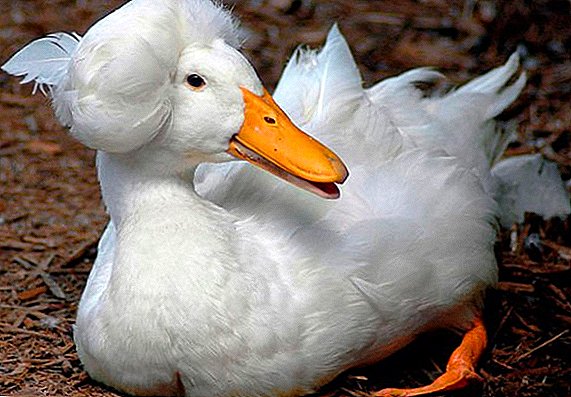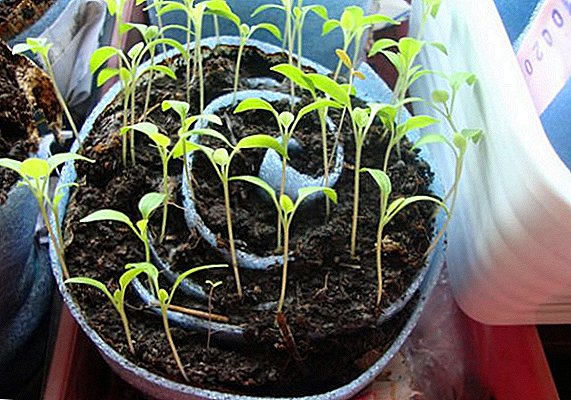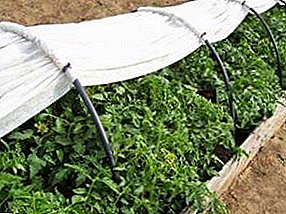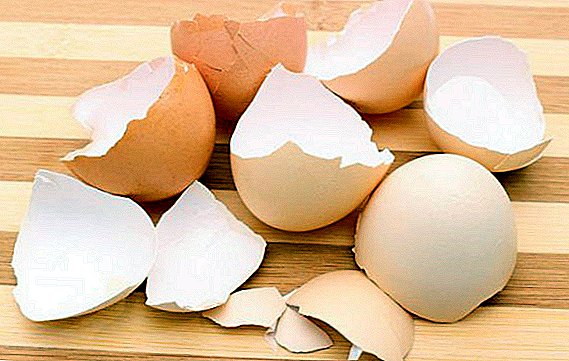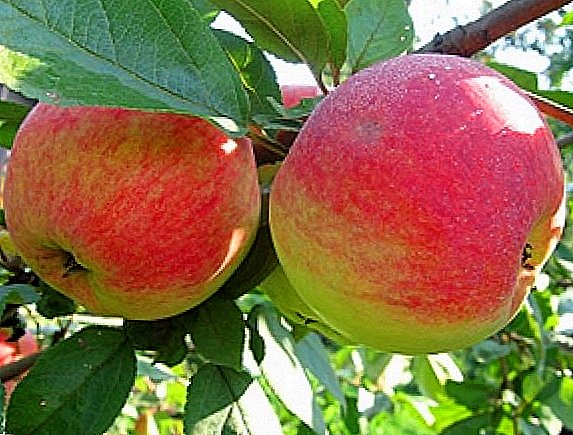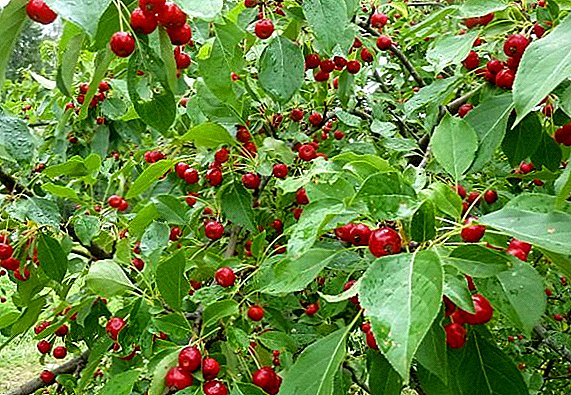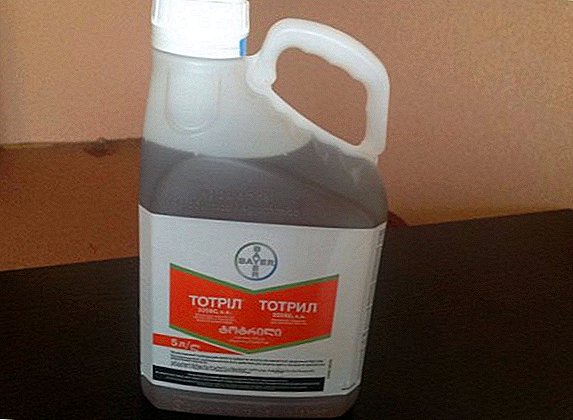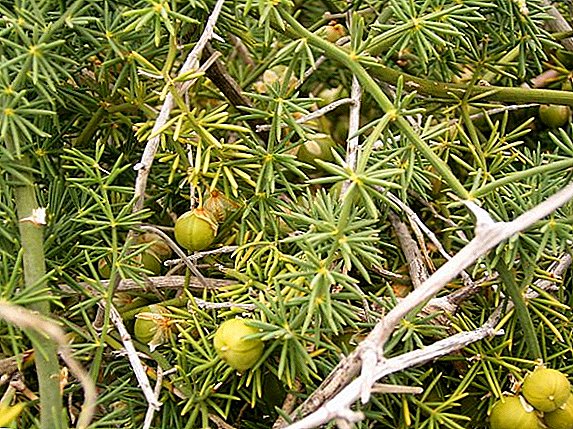 Asparagus - a long and familiar plant for every gardener.
Asparagus - a long and familiar plant for every gardener.
On the European continent, it first appeared more than two centuries ago.
But a few decades ago, asparagus experienced a real surge of popularity - it could be found at home at almost every grower.
But today the position of this amazing plant is not shaken at all.
In appearance, asparagus resembles a fern, but in fact it represents the family of asparagus.
Did you know? Some types of asparagus, referred to as asparagus can be eaten. As a rule, they are grown on special plantations as a vegetable plant. Young shoots of this plant are edible and often used in cooking.
There are hundreds of species of asparagus known to science, but only a few of them are suitable for growing at home.
Optimal conditions for asparagus at home
 The main advantage of asparagus is that care for him at home is quite simple. Try to provide this “green inhabitant” with the conditions closest to natural conditions, and do not forget about timely watering. But in order to get beautiful and lush greenery, follow certain rules, and surround the plant with proper care.
The main advantage of asparagus is that care for him at home is quite simple. Try to provide this “green inhabitant” with the conditions closest to natural conditions, and do not forget about timely watering. But in order to get beautiful and lush greenery, follow certain rules, and surround the plant with proper care.
Location and lighting
The ideal place for placing asparagus in a room is the window sill of the window, which is located on the north-west or north-east side.
Asparagus - very light-loving plant. If the room is on the south side, the pot should be placed at a short distance from the window. In winter, indoor asparagus may lack natural light, so at this time of year it should be moved closer to sunlight.
Normal sill is a great place for this plant. Immediately after the purchase or after the rest period, the plant is not recommended to be exposed to intense light.
 Instead, asparagus needs to be arranged. transitional stage. Place it in a slightly darkened place and gradually move it closer to the light source. If you decide to put asparagus on the balcony or in the garden for the summer, do not forget to take a few days to adapt and accustom the plant to new conditions.
Instead, asparagus needs to be arranged. transitional stage. Place it in a slightly darkened place and gradually move it closer to the light source. If you decide to put asparagus on the balcony or in the garden for the summer, do not forget to take a few days to adapt and accustom the plant to new conditions.
Temperature
Regarding the temperature regime for asparagus, in the warm season, the most comfortable indicator will be from +22 to +25 ° С. In winter, the temperature should be between +12 and +15 ° C. The heat of these "fluffy Christmas trees" is not well tolerated, so on hot summer days they need additional shading and spraying.
Important! Lowering the temperature to 0 degrees in winter may cause the stems to drop all their needle leaves.
Features care asparagus in the process of growing
Asparagus needs compulsory, periodic spraying. If the plant will be grown as a decorative indoor flower, then you can do without prior preparation of seeds. Also do not forget about the temperature in the room, its figure should be at least 18 ° C.
Proper watering at different times of the year
 When caring for asparagus, do not forget that this plant is very moisture-loving and throughout the entire period of active growing season (early spring - mid-autumn) needs abundant and frequent watering. It should be watered at least 3 times a week with water that was previously settled for a day.
When caring for asparagus, do not forget that this plant is very moisture-loving and throughout the entire period of active growing season (early spring - mid-autumn) needs abundant and frequent watering. It should be watered at least 3 times a week with water that was previously settled for a day.
Watering asparagus requires such a quantity of water that by the next watering the topsoil can dry out and the middle and deep layers still remain wet.
Drying of the soil should be avoided, and stagnation of water in the sump should not be allowed, as this may lead to rotting of the root system. Drain excess moisture from the pan about half an hour after watering.
With the onset of autumn should gradually reduce the intensity of irrigation. In the dormant period, during which future shoots are laid in the depth of the pot, the soil moisture should remain optimal. To fulfill this condition, it is enough just to water asparagus no more than 2 times a week.
Important! In the fall, use the method of lower irrigation: it involves pouring water not into the pot itself, but into the pan. The main thing - do not forget to be sure to drain excess fluid.
Air humidity
Moisture-loving asparagus feels great in a room with a moderate or high level of humidity. If you daily spray his sprigs from a spray bottle, he will immediately respond to this. Such a reaction will manifest itself in enhancing the color of the leaves and increasing the crown.
 If the plant is contained in a room with dry air, then the situation can be significantly improved with the help of a pallet. Fill it with coarse raw sand or wet pebbles and simply put a plant pot there. Some growers use wet moss as a filler, but in this case it is necessary to remember about the need for its annual replacement.
If the plant is contained in a room with dry air, then the situation can be significantly improved with the help of a pallet. Fill it with coarse raw sand or wet pebbles and simply put a plant pot there. Some growers use wet moss as a filler, but in this case it is necessary to remember about the need for its annual replacement.
Important! You can increase the humidity in the room with the help of a regular can - just fill it with water and place it next to asparagus.
Top dressing and fertilizer of the soil
Asparagus for growing need easy, fertile, friable and subacidic soil. In this regard, asparagus is a very unpretentious plant, since the soil for its cultivation is done at home. To do this, simply take two parts of humus and add to this mass one part of washed river sand and leaf soil.
Also, growers prepare soil mixture from equal amounts of greenhouse soil, garden soil and river sand. If it is not possible to make a soil mix yourself, then you can use a universal primer, which is sold in any flower shop. 
Growing asparagus needs regular fertilizing:
- Starting from early spring (vegetative period), asparagus needs to be fed every 2 weeks with solutions of liquid complex fertilizers (for example, "Rainbow" or "Hyacinth"). Be sure to comply with the dosage specified in the instructions for a particular drug.
- Also in the pot to the asparagus weekly, you can add special organic or mineral fertilizers intended for indoor plants.
- Single fertilization of soil with bird droppings during the summer season will provide a large number of healthy, young shoots.
- Regular spraying of shoots of growth bud "Bud" dissolved in water (1 gram of the drug per 1 liter of water) will make the asparagus crown healthy, fresh and very bright.
Correct pruning
 Healthy asparagus does not need pruning. Remember that pruning healthy shoots of a plant can completely stop their growth.
Healthy asparagus does not need pruning. Remember that pruning healthy shoots of a plant can completely stop their growth.
Trim as wilted and yellowed shoots appear, and also remove any bare shoots. Pruning contributes to the active growth of new shoots. Asparagus pruning is usually done in the spring, simultaneously with the transplant of a plant.
Did you know? The most ancient cultural species is considered to be asparagus pharmacy ordinary, often referred to as asparagus.
Repotting and ground mixture
After that, as the plant reaches the age of five transplantation is carried out annually. Upon reaching 7 years old, the root system is no longer actively developing and Asparagus transplanted every 3 years.
When transplanting, it is necessary to trim the root system of the plant slightly. The soil mixture necessary for the plant can be prepared independently. To do this, simply mix the following components: sifted sod land, vegetable humus and river sand.
Do not forget to moisten the prepared soil well. Put a drainage layer on the bottom of the pot and then fill it with nutritious soil mixture. Such a mixture should consist of one part of river sand and two parts of light nutrient soil.
 After the completion of transplantation, asparagus should be watered abundantly, and a week later fed.
After the completion of transplantation, asparagus should be watered abundantly, and a week later fed.
After planting, take care of sufficient air supply - this is necessary to prevent acidification of the soil.
Reproduction of asparagus at home
Reproduction of asparagus includes 3 main ways. All of them are widely used by both experienced growers and beginners. Their main advantage is that they are all available at home.
Rhizome division
During the annual asparagus transplant, depending on the size, The plant can be divided into several parts. After that, they land in a separate landing tank. The main rule - when dividing, do not forget to cut off such a part of asparagus, as the roots. Such a breeding method is the least traumatic for asparagus.
Stem cuttings
This method of reproduction is carried out in early spring. Cut the plant shoots should be approximately 10 centimeters in length. River rooting is used to root the cuttings.
 Also, the container with the cuttings should be covered with polyethylene in order to reduce the evaporation of moisture. After that, the container is placed in a bright place with a temperature of +20 to +22 ° C. Do not forget to air and moisten the landing daily.
Also, the container with the cuttings should be covered with polyethylene in order to reduce the evaporation of moisture. After that, the container is placed in a bright place with a temperature of +20 to +22 ° C. Do not forget to air and moisten the landing daily.
In total, the rooting process takes about 30 days. After this period, asparagus must be transplanted to a permanent place.
Did you know? Asparagus easily adapts to a variety of conditions, which contributes to the rapid dispersal of this plant. The process of spreading asparagus around the world is facilitated by birds, who eat the berries of the plant and spread the seeds for hundreds of kilometers.
Seed method
After artificial pollination, asparagus produces fruits from which seeds can be extracted. In order to grow a strong plant, sowing seeds must be made immediately after they are harvested. Usually, seeds are harvested from January to March.
The most optimal soil for planting should consist of equal parts of river sand and peat. Soil mixture must be well watered, and after that in the already moistened soil to plant seeds.
 Then the container with the seeds covered with a film and put in a bright place with a temperature of 20-22 ° C. Condensation drops on the film indicate that the seedlings need to be ventilated. Within a month, the first shoots appear at the site of planting.
Then the container with the seeds covered with a film and put in a bright place with a temperature of 20-22 ° C. Condensation drops on the film indicate that the seedlings need to be ventilated. Within a month, the first shoots appear at the site of planting.
After saplings reach 10 cm in height, they need swoop down (transplanted with the root system). As a rule, the grown-up plants are transplanted to a new place in June.
Asparagus is a real delight for the florist. Show proper attention to him, and the plant will certainly delight you and your loved ones!


